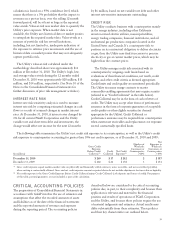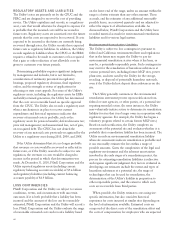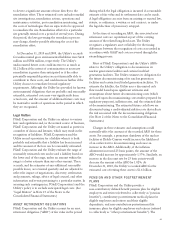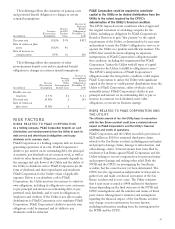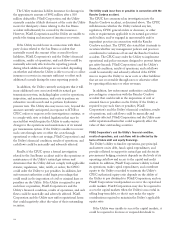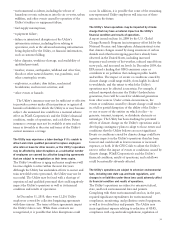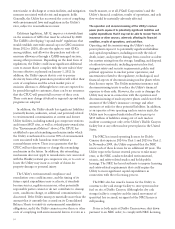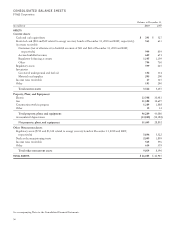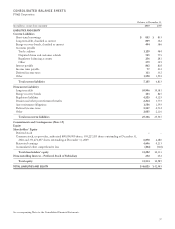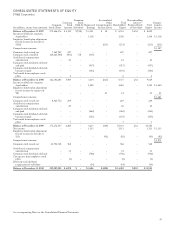PG&E 2010 Annual Report Download - page 53
Download and view the complete annual report
Please find page 53 of the 2010 PG&E annual report below. You can navigate through the pages in the report by either clicking on the pages listed below, or by using the keyword search tool below to find specific information within the annual report.incurred by the Utility underpowerpurchase agreements it
entersinto to meet applicable resource adequacy and
renewable energy requirements if the CPUC finds that the
costs areunreasonably above-market inthe future.
The Utility must achieve an electricity planning reserve
margin of 15% to 17% in excess of peak capacity electricity
requirements. The Utility must also meet “local” resource
adequacy requirements for specific regions in which
locally-situated electricity capacity may be needed due to
transmission constraints. The CPUC can impose a penalty
if the Utility fails to acquire sufficient capacity to meet
these resource adequacy requirements for a particular year.
The penalty for failure to procure sufficient system
resource adequacy capacity (i.e., resources that are
deliverable anywhere in the CAISO-controlled electricity
grid) is up to $80 per kW-year. The CPUC set the penalty
for failure to meet local resource adequacy requirements at
$40 per kW-year. In addition to penalties, the CAISO can
require LSEs that fail to meet their resource adequacy
requirements to pay the CAISO’s cost of buying electricity
capacity to fulfill the LSEs’ resource adequacy target levels.
California law requires retail sellers such as the Utility to
comply with the RPS by increasing their deliveries of
renewable energy each year so that the amount of
electricity delivered from eligible renewable resources
equals at least 20% of their total retail sales by the end of
2010. If a retail seller is unable to meet its target for a
particular year, the current CPUC “flexible compliance”
rules allow the deficit to be carried forward for up to three
years (i.e., to 2013), so that future deliveries of renewable
power can be used to make up the deficit. The CPUC also
permits the use of a limited amount of tradable RECs to
meet RPS requirements. (See “Environmental Matters –
Renewable Energy Resources” above.) The CPUC can
impose penalties of $50 per MWh, up to $25 million per
year, for an unexcused failure to comply with the current
RPS requirements. The CPUC can excuse noncompliance
if a retail seller is able to demonstrate good cause, such as
insufficient transmission capacity or the failure of the
renewable energy provider to timely develop a renewable
resource.
In addition, under its authority to implement AB 32,
the CARB adopted regulations on September 23, 2010 that
require virtually all load-serving entities, including the
Utility, to increase their deliveries of renewable energy to
meet specific annual targets. For 2012, 2013, and 2014, the
amount of electricity delivered from renewable energy
resources must equal at least 20% of total energy deliveries,
increasing to 24% in 2015, 2016, and 2017, 28% in 2018
and 2019, and 33% in 2020 and beyond. The CARB can
impose penalties for failure to meet the targets but it is
unclear how the penalties would be calculated or whether
the total penalties are subject to an annual maximum
similar to the maximum that the CPUC adopted.
Finally, proposed legislation also has been introduced to
the California Legislature that, if adopted, would increase
the RPS to 33% by 2020.
Following several request for offers (“RFOs”) and
bilateral negotiations, the Utility entered into various
agreements to purchase renewable generation to be
produced by facilities proposed to be developed by third
parties. The Utility expects that it will enter into additional
agreements in the future. The development of these
renewable generation facilities is subject to many risks,
including risks related to permitting, financing, technology,
fuel supply, environmental matters, and the construction
of sufficient transmission capacity. Whether the Utility can
meet the renewable energy requirements depends on timely
development of renewable energy facilities. Further, as the
market for renewable energy develops, there is a risk that
the Utility’s contractual commitments could result in
procurement costs that are higher than the market price of
renewable energy in the future. Although the Utility
believes that it will continue to be able to recover the costs
it incurs under these agreements in rates as part of the pass-
through cost of electricity, there is a risk that the CPUC
could disallow such costs in the future to the extent the
CPUC considers the Utility’s costs to be unreasonably
above market.
The Utility faces the risk of unrecoverable costs if its
customers obtaindistributionandtransportationservices from
otherprovidersasaresult of municipalization, technological
change, orotherforms of bypass.
The Utility’s customers could bypass its distribution and
transportation system by obtaining such services from
other providers. This may result in stranded investment
capital, loss of customer growth, and additional barriers to
cost recovery. Forms of bypass of the Utility’s electricity
distribution system include construction of duplicate
distribution facilities to serve specific existing or new
customers and condemnation of the Utility’s distribution
facilities by local governments or municipal districts. Also,
the Utility’s natural gas transportation facilities could risk
being bypassed by interstate pipeline companies that
construct facilities in the Utility’s markets, by customers
who build pipeline connections that bypass the Utility’s
natural gas transportation and distribution system, or by
customers who use and transport liquefied natural gas.
If the number of the Utility’s customers declines due to
municipalization or other forms of bypass and the Utility’s
rates are not adjusted in a timely manner to allow it to fully
recover its investment in electricity and natural gas facilities
49


